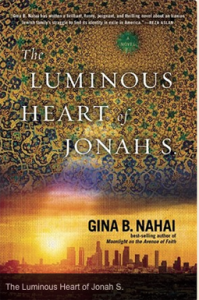The Luminous Heart of Jonah S. By Gina B. Nahai; 413 pages. Akashic Books. $29.95
By Janice Steinberg

 SAN DIEGO– The term “magic realism” arose to describe the juxtaposition of the everyday and the fantastic in novels by Latin American authors like Gabriel García Márquez. In her first novel, Cry of the Peacock (1992), Gina B. Nahai emerged as a deft practitioner of magic realism set in a very different cultural context—the Jewish community of Iran. Nahai, who was born in Iran and immigrated to Los Angeles shortly before the 1979 revolution, introduced Western readers to a 3,000-year-old community marked, for most of its history, by brutal poverty and oppression … and by a culture rich in folktales. And the novel introduced Nahai—who appeared at the San Diego Jewish Book Fair in November—as a master storyteller with a gift for sensual prose.
SAN DIEGO– The term “magic realism” arose to describe the juxtaposition of the everyday and the fantastic in novels by Latin American authors like Gabriel García Márquez. In her first novel, Cry of the Peacock (1992), Gina B. Nahai emerged as a deft practitioner of magic realism set in a very different cultural context—the Jewish community of Iran. Nahai, who was born in Iran and immigrated to Los Angeles shortly before the 1979 revolution, introduced Western readers to a 3,000-year-old community marked, for most of its history, by brutal poverty and oppression … and by a culture rich in folktales. And the novel introduced Nahai—who appeared at the San Diego Jewish Book Fair in November—as a master storyteller with a gift for sensual prose.
Decades of living in the U.S. haven’t dimmed Nahai’s skills as a fabulist. Her latest novel (her fifth), The Luminous Heart of Jonah S., involves a lust for revenge that has its roots in Tehran, with a sleepwalker whose heart glows within his chest at night. Raphael Solyeman is the son of an Iranian Jewish family that prospered under the shah; however, their wealth can’t keep him from roaming the streets in his sleep, “the light from his heart attracting every moth and firefly and nocturnal bird in the city, plus a horde of restless, insomniac ghosts.” On one such semi-conscious ramble, he meets a destitute, hideous Jewess, the Black Bitch of Bushehr. (Nahai’s genius for naming reminds me of Dickens.) After Raphael dies, the Black Bitch shows up with a son that she claims is his, a boy she has named Raphael’s Son, and demands that the Soleymans recognize him as their own. When they refuse, her revenge is titanic: a house floods, a child disappears. Raphael’s Son inherits the insatiable quest for payback, which spans continents as he—along with thousands of Iranian Jews—moves to Los Angeles.
Sections of the novel that unfold in Tehran glow like Raphael’s heart, the events mythic in scale and the language intoxicating. A substantial part of the story also takes place in Los Angeles; in fact, the book opens with Raphael’s Son’s murder, and the murder investigation provides the frame in which we learn about the enmity born in Tehran. And, reading the narrative set in Los Angeles, I had the sense of something precious being lost.
The magic realism isn’t gone, not entirely. Nahai’s Los Angeles, like her Tehran, is the setting for otherworldly occurrences. For instance, Raphael’s Son is reported to be sitting in his car, his throat slashed, but by the time the police arrive, his body has vanished. But the Los Angeles chapters are weighted with material detail. Precise times—4:45 a.m., 12:15 p.m.—and descriptions that include ages and heights have the just-the-facts-ma’am style of a dated detective novel. And everything is given a price tag: $2,800 Zegna suits, $700 jeans, a $3,000 table at a posh club, a $1,700,000 Bugatti.
As a critique of the materialism of Los Angeles’s Iranian-Jewish community, the price-tagging is wicked. And Nahai brings a sharp social satirist’s eye to all of post-millennial multi-cultural L.A., in which “all the pharmacists (at Rite-Aid) are Iranian, the cashiers are Filipino, and the store clerks are Latino; white people, it seems, do not work at Rite-Aid.” With the satire, though, comes a snarky tone. No matter how evil her characters are in Iran, Nahai writes them with a certain affection and even wonder, the way we regard monsters in fables. When the location shifts to L.A., the wonder is gone; instead, she’s often snide. That’s no doubt an apt metaphor for the enormous loss that occurs when a culture is exiled from its native soil. But it makes the pleasures of this novel, though they are many, less luminous than they might be.
*
Steinberg is a freelance writer specializing in coverage of literature and the arts. Your comment may be posted in the space provided below or sent directly to the author at janice.steinberg@sdjewishworld.com